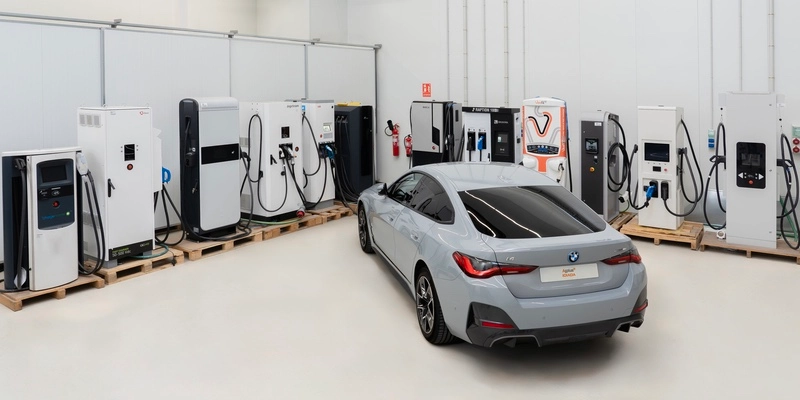Spain boasts world-renowned manufacturers of charging infrastructure known for their quality.
All of them are achieving a market share of over 20 per cent in Europe and a turnover that exceeded 300 million euros in 2022.
In 2023, out of the 354,000 chargers produced locally, 294,000 were exported, according to data from the Business Association for the Development and Promotion of Electric Mobility (AEDIVE).
To maintain these standards of quality and competitiveness in the global market, products must undergo a rigorous certification process.
What are the main challenges?

“Perhaps the greatest challenges of power electronics and chargers, which are power devices, are electromagnetic compatibility (EMC) and communication,” says Miquel Maureso, Head of e-Powertrain at Applus+IDIADA.
In dialogue with Mobility Portal España, the division that offers design, engineering, testing, and homologation services, also provides pre-validation rounds, mainly aimed at “manufacturers who are just starting out or products that are newly designed.”
For those who have doubts about any aspect of the regulations, pre-validations can be very helpful as they allow problems to be resolved quickly before official accreditation tests are carried out.
There are as many eMobility standards as there are markets
The reality is that there are currently several charging standards.
This means that European manufacturers wishing to export their products to other continents must certify them according to the specific requirements of each region.
And each time a new technical feature is introduced or an existing one is modified, a new homologation is required.
These regulations and safety requirements also vary for vehicles, meaning that the same car cannot be sold in Europe, the United States, Japan, or Korea.
“It would be simpler if there were a global standard, but countries regulate these aspects for various reasons, such as specific market needs, safety or environmental requirements, and also due to protectionism,” comments the Head of e-Powertrain at Applus+IDIADA.
The difference in interpretations

“There are many details in the standard that can sometimes be interpreted in different ways, so we help to refine them very well,” explains Laia Edo, EV Charging Coordinator.
This helps to ensure that any flaws are corrected before official accreditation, so that companies present themselves more confidently.
This work is carried out with proprietary tools such as simulators that emulate the behavior of a charger or vehicle, which allow verification of the correct functioning of the different protocols to pass these tests. For example, in the case of vehicle charging, in Europe, those of the CCS2.
Then, tests are carried out against commercial equipment (vehicle against chargers and charger against vehicles), culminating in tests on the street to evaluate vehicles in real conditions.
What steps should a manufacturer follow for this process to be successful?
“If they are familiar with the standards and their specialists prepare the equipment to comply with them, that is, if they design and carry out internal tests correctly, accreditation tests should be a formality,” she assures.
The total time for the charger validation process, from preparation to testing, is usually “two or three months.”
According to her, this period varies depending on whether the manufacturer is starting from scratch or already has similar products and only makes small modifications.
“In our laboratory, we have chargers that represent approximately 80 per cent of the European market, and we have them here in Spain,” details Miquel Maureso.
Additionally, they have a laboratory in Shanghai, China, equipped with around 30 or 40 devices, another in Ingolstadt, Germany, and another in Los Angeles, United States.
This network of laboratories strategically positions Applus+ IDIADA in meeting the needs of the global electric vehicle market.
Not only that, but Applus+IDIADA also prepares these vehicles to be sold in other regions, such as the United States, China, or Japan.
In the past, Japanese cars sold in Europe used the CHAdeMO connector/protocol, IDIADA is accredited by this organization to validate their devices.
This protocol/connector is used in Japan and other countries in its sphere of influence, but outside of Japan, it is becoming increasingly obsolete.
The ChaoJi, a new system in development between China and Japan, aims to be the evolution of the CHAdeMO protocol; more powerful and with the goal of covering the charging infrastructure of both countries and their sphere of influence.
The NACS, originally known as the “Tesla Protocol,” is gaining strength in the United States. Applus+ IDIADA is already prepared for its validation.
“We conduct tests with both vehicle and charger manufacturers, so we have an activity that is a ‘win-win’ for both,” he emphasizes.
In this way, IDIADA acts as an intermediary between both actors, and often, charging equipment companies decide to leave their products for testing with several vehicles and then improve their product.
It is worth noting that the entity is accredited by ENAC, according to the ISO17025 standard, for the performance of most of the tests of the IEC 68151 standard for charger certification, allowing it to offer its clients specific tests related to charging, communication, technical aspects, and electrical safety.








